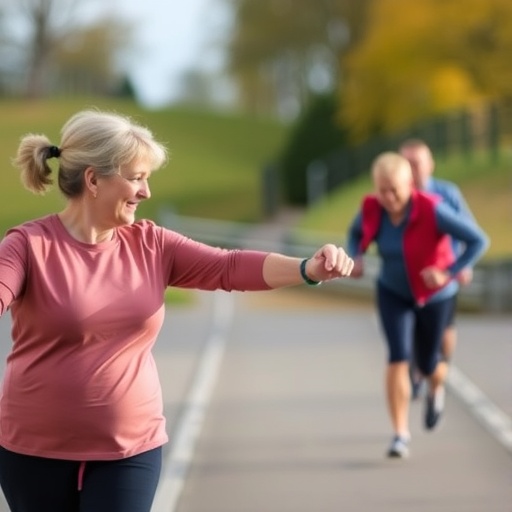In a comprehensive study by Qin et al. published in BMC Geriatrics, the authors delved into the critical realm of exercise prescription for older adults, revealing an alarming gap between established guidelines and actual practices among healthcare professionals in China. These findings raise pertinent questions regarding the adherence to exercise regimens that have been scientifically validated to promote health and longevity in the aging population. As the global demographic shifts towards an increasingly aged society, it is vital to scrutinize the factors that inhibit the effective implementation of exercise recommendations tailored for older adults.
Exercise is universally acknowledged as a cornerstone of healthy aging, yet the study identifies a significant disconnect between the intent to prescribe exercise and the actual recommendations made by healthcare providers. This disparity, frequently referred to as the “implementation gap,” is a critical concern that can have far-reaching consequences on the well-being of elderly patients. The intricacies of this gap arise not from a lack of understanding of the benefits of exercise but stem from various institutional, educational, and personal barriers faced by healthcare professionals.
The survey, which captured insights from a substantial number of healthcare professionals across various regions in China, exposed a myriad of challenges that complicate the delivery of exercise prescriptions. Respondents highlighted systemic issues such as inadequate training in exercise prescription, limited resources for implementing physical activity programs, and a lack of interdisciplinary collaboration among healthcare providers. These challenges underscore the necessity for an educational overhaul that emphasizes not only the health benefits of exercise but also provides practical guidance on how to integrate physical activity into patient care.
Moreover, the survey revealed that many healthcare professionals operate under the misconception that older adults are largely unmotivated or incapable of engaging in physical activity. This ageist perspective can severely impact the frequency and quality of exercise prescriptions perceived by older adults as viable by providers. Therefore, a cultural shift within the healthcare community is paramount to begin addressing the stigmas associated with aging and physical activity. Education and advocacy should be directed not only toward healthcare providers but also to dispel myths surrounding aging within the broader community.
In order to capitalize on the health benefits that exercise can confer upon older adults, a multifaceted strategy is required. This encompasses the development of structured training programs for healthcare professionals, which would enhance their competencies in constructing tailored exercise prescriptions that meet the unique needs of older patients. Furthermore, initiatives aimed at fostering collaboration within healthcare teams can create a more supportive environment in which older adults feel encouraged and empowered to engage in physical activity.
The issues outlined in Qin et al.’s study are not isolated to China but reflect a global dilemma in geriatric care. As more countries confront the challenges associated with rapidly aging populations, the insights garnered from this research can serve as a valuable framework. Policymakers and health system leaders must prioritize geriatric training and support systems that encourage healthcare professionals to adopt exercise prescriptions as an integral component of comprehensive care for older adults.
Indeed, the provision of exercise prescriptions is a complex task that involves understanding the diverse motivations and barriers faced by older adults. Tailoring these prescriptions to not only enhance physical capability but also to consider psychosocial factors can lead to better adherence rates and, ultimately, improved health outcomes. Efforts should also be made to directly engage older adults in the conversation regarding their physical health, involving them in decision-making processes that affect their health interventions.
Ultimately, the findings from Qin et al. beckon a proactive approach to rectify the identified implementation gap. Stakeholders within the healthcare system are challenged to reflect on their practices and biases while seeking to understand the unique circumstances of older adults. By fostering an inclusive culture of health that promotes exercise as a normalized aspect of aging, we can pave the way for a healthier, more engaged senior population.
In summary, the critical examination of exercise prescription practices for older adults serves as a vital wake-up call to the healthcare community. The urgent need to address the systemic barriers identified in Qin et al.’s research cannot be overstated. As elderly demographics continue to rise, the implications of neglecting exercise as an essential modality in geriatric care can lead to significant health deteriorations and quality of life declines among our aging population.
Moving forward, the insights revealed in this survey must not only be acknowledged but acted upon. Instituting reforms within educational systems, healthcare policies, and cultural perceptions around aging and physical activity will be instrumental in bridging the implementation gap. This endeavor will require commitment from all facets of the healthcare sector, fostering an environment conducive to change and growth for older adults seeking to lead active, fulfilling lives.
As we reflect on the importance of optimizing health throughout the shifting demographics of our society, the call to action becomes evident: integrating exercise prescriptions into the fabric of geriatric care represents not just a clinical obligation, but a moral imperative to enhance the quality of life for our aging citizens.
In closing, Qin et al.’s research serves as a clarion call for systemic change and dedication to the health of older adults. By addressing the implementation gap and dismantling the barriers to exercise prescriptions, we can work towards a future where all elderly individuals have the opportunity to embrace an active and healthy lifestyle.
Subject of Research: Implementation gap and influencing factors of exercise prescription for older adults.
Article Title: Implementation gap and influencing factors of exercise prescription for older adults: a large-scale survey of healthcare professionals in China.
Article References:
Qin, C., Hua, N., Wang, A. et al. Implementation gap and influencing factors of exercise prescription for older adults: a large-scale survey of healthcare professionals in China.
BMC Geriatr 25, 967 (2025). https://doi.org/10.1186/s12877-025-06686-y
Image Credits: AI Generated
DOI: https://doi.org/10.1186/s12877-025-06686-y
Keywords: Exercise Prescription, Older Adults, Healthcare Professionals, Implementation Gap, Geriatric Care, Physical Activity, China.
Tags: aging population health strategiesbarriers to exercise recommendationsexercise prescription for older adultsexercise regimens for older adultshealthcare education for elderly carehealthcare professionals and exercise guidelinesimpact of exercise on healthy agingimplementation gap in healthcareimproving health outcomes for seniorsinstitutional challenges in exercise prescriptionpromoting physical activity in seniorsstudy on exercise adherence in elderly





